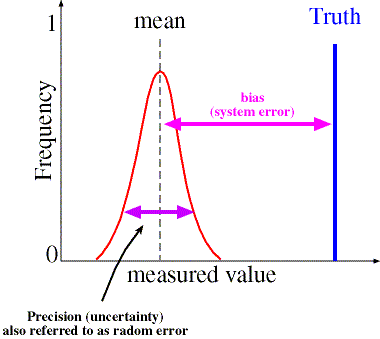Accuracy (bias)
|
is the difference between your measurement (mean value) and the truth. A good analyses should include bias estimates as well. Important: accuracy is not the same as uncertainty! e.g. can have an accurate measurement with a large uncertainty
|
Bias (systematic) and Random Errors
|
Systematic/bias errors are consistent and repeatable. Random errors arise from random fluctuations in the measurements
|
To differentiate between the two:
|
Random errors are reduced when experiment is repeated many times, get a mean value. It can be studied through statistical analysis of repeated measurements e.g. mean, standard deviation, and variance are often used.
|
The systematic error (bias)
|
will not change. It’s a very common type of error. It could be can be studied through intercomparisons, calibrations, and error propagation.
(source http://apollo.lsc.vsc.edu/classes/remote/)
|
The overall quality of a model can reasonably be described through a single parameter, called the bias.
In qsaR you can just type the command bias(), to get all the things automatically done for the all six models. The final results is showed in the figure bellow saved under the name “bias.png”.
 * to produce the graph just type the command
* to produce the graph just type the command bias()

